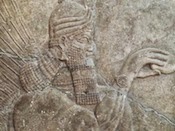 |
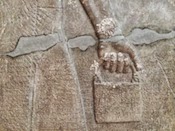 |
| Assyrian Reliefs: It’s Not a Purse, It’s Assyrian! | |
This empty nest travel blog couple bought a 3-day Istanbul museum card in part because it gave us access to a couple of the lesser-known, lesser-visited museums in the city. Two of those museums deserve special note: the Archaeology Museum and the Mosaic Museum.
We are archaeology nuts. When we were kids, we both fancied being archaeologists, even before there was an Indiana Jones. So if there’s an archaeology museum around, count us in. Istanbul–previously Constantinople and pre-previously Byzantium–is right up there with Rome for archaeological interest. There are sites of importance all over the city.
The Archaeology Museum, nestled in one corner of the Topkapi Palace compound, is itself a compound of three separate museums-within-a-museum: the main archaeology museum, the Museum of the Ancient Orient, and the Museum of Islamic Art. There are also expansive boneyards of artifacts and remains, even filling the yard of the museum café and spilling out into the area around the museum. Oddly positioned at the end of the Arasta Bazaar, you’ll find the Mosaic Museum: a quick tour of an underground excavation exposing floor mosaics that date back to when the city was called Byzantium. Here are a few of the hilites of these museums that most impressed us.
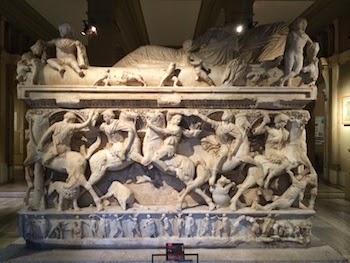 |
| Sarcophagus of Sidamara |
Sarcophagus of Sidarma
One of the top draws at the Istanbul Archaeology Museum is a sarcophagus known as the Sarcophagus of Alexander. You’d think it once held the remains of Alexander the Great, or at least someone else named Alexander. But this (allegedly) great sarcophagus is so-called not because of its original occupant but instead because of its exterior decorations. Unfortunately, the famed Alexander sarcophagus was unavailable to us due to construction at the museum when we visited. Instead, we were wowed by this other splendid Sarcophagus of Sidarma, dating from the 3rd century.
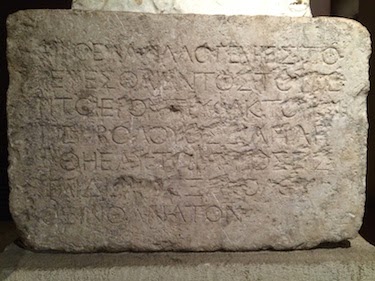 |
| Inscription from the Temple in Jerusalem |
Inscription from the Temple in Jerusalem
Everyone knows that the temple in Jerusalem was destroyed in 70AD, but it hadn’t occurred to us that pieces of it might be spread here and there. In Istanbul’s Archaeology museum we found a stone inscription surviving from the temple. It’s a warning sign that used to stand outside the entrance to the courtyard of the sacred temple. It reads: “No intruder is allowed in the courtyard and within the wall surrounding the temple. Whoever enters will invite death for himself.” We like how no words are minced here.
 |
| Ancient Floor in the Mosaic Museum |
 |
| Mosaic Close-up: Two Dudes on a Camel Roadtrip |
Ancient Floors in the Mosaic Museum
Two things stand out when strolling through the mosaic museum: the artistic detail of the mosaics and their sheer extent. The esplanade on display is just a small part of what remains unexcavated a few feet below the areas beneath the Blue Mosque and the Hagia Sophia (perhaps acres), yet what’s there is extensive, especially considering the amount of time it took the artists to create these mosaics–all just to decorate the floors–to begin with. These mosaics date to when the city was called Byzantium.
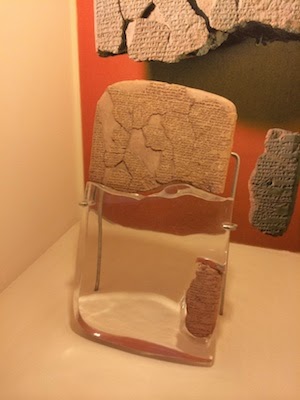 |
| The Kadesh Treaty |
The Kadesh Treaty
This treaty, literally written in stone, is the earliest known peace treaty. It ended a war between the Hitites and Egyptians in 1269 BC, when Ramses II was the pharaoh. It was written in the “common tongue” of the day, a language called Akkadian. Several copies were made and distributed (presumably so everyone knew of the peace accord), and three copies survive today: two at the Istanbul museum, one at the Staatliche Museum in Berlin. It’s a testament to mankind’s desire to achieve peace, but as the peace it created only held for a few years, it’s also a testament to how frail peace can be.
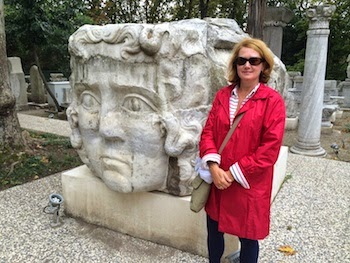 |
| Lori and a Column Capital in the Museum “Boneyard” (Imagine the column this once sat atop) |






